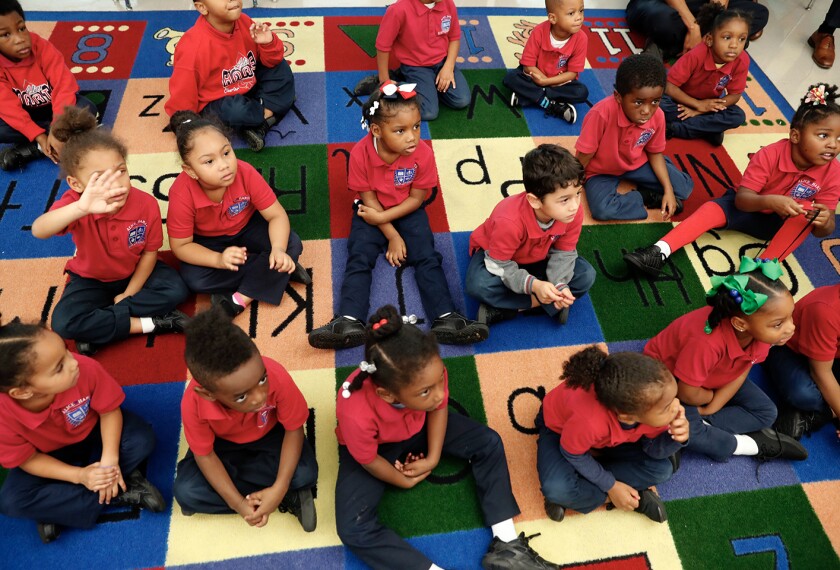By this summer, all states will be required to have “early-learning guidelines” for young children that are aligned with their K-12 standards—part of the Bush administration’s push to improve the quality of early-childhood programs and boost children’s reading skills.
To help states better understand the administration’s vision of high-quality early-learning programs, officials from the Department of Education and the Department of Health and Human Services have been holding a series of regional early-childhood educator “academies” in recent months.
Two-day sessions have already been held in Los Angeles, St. Louis, and Miami. A fourth one is scheduled for Lowell, Mass., on April 7-8.
Education Department officials said the purpose of the meetings is to send a strong message that reading difficulties can be prevented if the nation takes a more active approach to early-childhood learning.
While the guidelines for 3- to 5-year-olds will be optional for most local child-care centers and preschools, Education Department officials said preschool programs that are financed with federal Title I money will eventually be required to use those standards.
While some states—such as California, Massachusetts, and North Carolina—have already been drawing up preschool standards, others haven’t even started.
Despite the Bush administration’s emphasis on the series of early-childhood academies, some educators who have attended the gatherings question whether the information presented has been well matched to the audience.
Though most of the attendees are experienced administrators and program leaders in their states, people who have been at the sessions said much of the information presented was focused on classroom instruction.
“A lot of time was devoted to classroom practice,” said Adele Robinson, the director of public policy and communications for the National Association for the Education of Young Children, a Washington-based advocacy and professional organization. “We and many others there had anticipated and wanted more of a discussion of state policies and the role of the state agencies.”
Ms. Robinson, who attended the Dec. 9-10 session in Miami, said participants “would have appreciated more information on what they will look for in the early-learning guidelines and professional-development plans.”
Susan B. Neuman, the Education Department’s assistant secretary for elementary and secondary education, said she had heard some of those complaints.
But Ms. Neuman, who announced last week that she would be leaving her post at the end of this month, said she did not believe the academies had been wasted on the wrong people.
“Someone said, ‘Well, I’m in policy—you’ve got the wrong person,’ ” she said. “But in my view, there is no way one can do policy without knowing the content.”
Barbara Pellin, the assistant superintendent for student, family, and community services for the 112,000-student Charlotte-Mecklenburg school system in North Carolina and one of the presenters at the first three sessions, called the meetings a “good mix of information.” She said the meetings have given state leaders a chance to review where they are and where they need to go.
“There is still this debate over what is developmentally appropriate and what is not,” Ms. Pellin said.
Ms. Neuman added that with the help of the Child Care Bureau, which is part of the HHS Department, additional regional “institutes” would be held for teachers and those who work closer to the classroom.
At the same time, Early Reading First grantees will soon be announced, giving early- childhood educators examples of “centers of excellence” to view in their own states as they begin to adopt the guidelines, according to Education Department officials. Early Reading First is a federal program set up to fund early- childhood programs that have strong literacy components.
Between 50 and 100 grants, totaling $750,000 to $1.5 million, will be awarded to early-childhood programs that are either affiliated with a district receiving a Reading First grant or located in the same community. The grantees will be programs that have already worked to improve early literacy instruction.
Greater Collaboration
Another purpose of the academies, Ms. Neuman said, has been to demonstrate the growing collaboration between the federal education and child-care agencies.
While states will submit their guidelines to HHS as part of their child-care plans on July 1, the Education Department will also be part of reviewing them, Ms. Neuman said.
“The [Education] Department will provide the leadership and the research base and the knowledge,” she said. “But [the Child Care Bureau] has the knowledge of the child-care field.”
In her comments to early-childhood leaders who attended the academies, Shannon Christian, the associate commissioner of the Child Care Bureau, noted that most 3- and 4-year-olds in out-of-home care do not attend formal preschool programs. Instead, they are in child-care centers, in family child-care homes, or in the care of a family friend or relative.
That’s one reason why the National Association of Child Care Resource and Referral Agencies, a Washington-based network of state and local agencies, plans to offer for the first time at its annual symposium in March a half-day session on how to improve quality in family child-care homes.
Experts point out that providers who care for children in their homes often don’t have the same access to professional development and training opportunities that center and school-based teachers have.
Linda Smith, the director of public policy and partnership for the child-care resource group, added that she hoped the federal government would take the next step and assist states in building better-organized systems of early-childhood education.
“Education and early education are still worlds apart,” she said.
Ms. Robinson of the NAEYC questioned whether some states were equipped to implement the guidelines, and said that the task would be more difficult now that states are cutting money to balance their budgets.
“It is important to understand that this also takes resources,” she said. “States should not be forced to stop a quality-improvement activity to fund a new one. Both should be well-financed to meet the goal of a system of high quality.”




